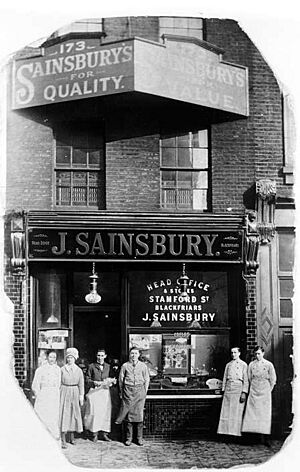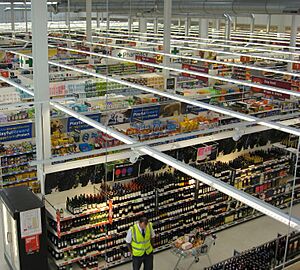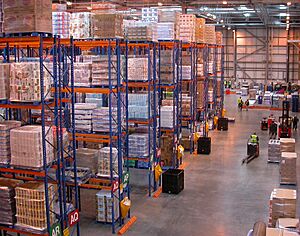Sainsbury's facts for kids

Logo used since 1999
|
|

|
|
|
Trade name
|
Sainsbury's |
|---|---|
| Public | |
| Traded as |
|
| Industry | Retailing |
| Founded | 1869 in Holborn, London, England |
| Founder | John James Sainsbury |
| Headquarters | London, England |
|
Area served
|
United Kingdom |
|
Key people
|
Martin Scicluna (chairman) Simon Roberts (CEO) |
| Products | Hypermarket/big-box store, supermarket, convenience store, forecourt shop |
| Brands | Argos Bush Habitat Nectar Tu |
| Revenue | |
|
Operating income
|
|
|
Number of employees
|
c. 152,000 (2024) |
| Subsidiaries |
|
J Sainsbury plc, known as Sainsbury's, is a large British supermarket chain. It is currently the second-biggest supermarket group in the United Kingdom.
Sainsbury's started in 1869 with a small shop in London. For most of the 1900s, it was the biggest grocery seller in the UK. However, in 1995, another supermarket called Tesco became the market leader. Sainsbury's has been second or third since then.
Today, J Sainsbury plc is divided into three main parts: Sainsbury's Supermarkets (which includes smaller convenience shops), Sainsbury's Bank, and Argos. The company also owns other popular brands like Habitat (furniture), Nectar (loyalty card), Tu (clothing), and Bush (electronics).
Contents
History of Sainsbury's
How Sainsbury's Started (1869–1955)
Sainsbury's began in 1869. John James Sainsbury and his wife, Mary Ann, opened their first shop at 173 Drury Lane in London. They started by selling fresh foods and later added packaged items like tea and sugar. John James Sainsbury's main idea was "Quality perfect, prices lower." This motto was even on a sign outside his first shop.
Sainsbury's shops in London started to look very similar. They all had a special cast-iron sign that said 'J. SAINSBURY'. This helped people recognise them from far away. They also started offering home deliveries, which was very convenient for customers.
By the time John James Sainsbury passed away in 1928, there were over 128 Sainsbury's shops. His oldest son, John Benjamin Sainsbury, took over the business.
During the 1930s and 1940s, Sainsbury's continued to improve its products and keep its shops clean and well-designed. In 1936, the company bought another chain of shops called Thoroughgood.
The founder's grandsons, Alan Sainsbury and Sir Robert Sainsbury, became joint managing directors in 1938. This happened after their father, John Benjamin Sainsbury, had a small heart attack.
During the Second World War, many men who worked for Sainsbury's went to serve their country. Women took their places in the shops. The war was tough for Sainsbury's because many of its London shops were bombed. Food was rationed, meaning people could only buy a limited amount.
Self-Service and Growth (1956–1991)
In 1956, Alan Sainsbury became the chairman. He had visited the United States and saw how successful self-service supermarkets were. He believed this was the future for Sainsbury's. The first self-service Sainsbury's shop opened in Croydon in 1950.
Sainsbury's was also one of the first to create its own-brand products. The goal was to offer good quality items at lower prices than famous national brands.
The company became a public company, J Sainsbury plc, on July 12, 1973. This meant that anyone could buy shares in the company. It was the biggest stock market launch in London at that time. The Sainsbury family still owned most of the shares.
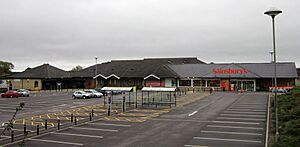
Many important jobs in the company were held by family members. John Davan Sainsbury, from the fourth generation of the family, became chairman in 1969.
Sainsbury's started replacing its smaller High Street shops with much larger self-service supermarkets. These new shops were often built outside of town or in new town centres. Sainsbury's focused on having well-designed shops and good quality products. Their slogan was "good food costs less at Sainsbury's." The last shop where staff served customers from behind counters closed in 1982.
To enter the hypermarket business (very large shops selling many different things), Sainsbury's teamed up with British Home Stores to create SavaCentre. The first SavaCentre opened in 1977. These large shops sold food, clothes, electronics, and more. Later, SavaCentre shops were changed to regular Sainsbury's superstores.
Sainsbury's also got involved in do-it-yourself (DIY) shops. In 1979, they partnered with a Belgian company to create Homebase stores. Sainsbury's sold the Homebase chain in 2000.
In the 1980s, Sainsbury's invested in new technology, like electronic checkouts that scanned products. In 1983, Sainsbury's bought a part of Shaw's Supermarkets in the United States, and later bought the rest of the company in 1987.
Sainsbury's continued to grow, opening new shops in large shopping centres. In 1992, Sainsbury's expanded into Scotland. They also planned to open shops in Northern Ireland, which they did between 1996 and 1998.
Challenges and Changes (1992–1998)
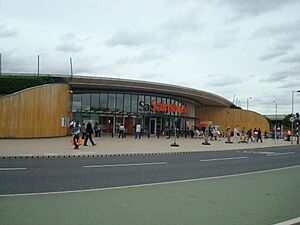
In 1992, David Sainsbury became chairman and chief executive. During this time, Sainsbury's made some mistakes. For example, they were slow to introduce loyalty cards, which their rival Tesco had. They also struggled with deciding whether to focus on quality or low prices.
In 1995, Sainsbury's lost its position as the UK's market leader to Tesco. However, some new ideas were successful, like starting Sainsbury's Bank in partnership with the Bank of Scotland.
Sainsbury's was also one of the first major grocery stores in the UK to offer a home delivery service in 1995.
In 1996, the company reported its first drop in profits in 22 years. David Sainsbury stepped down in 1998 to work in politics.
New Look and Strategy (1999–2003)
In 1999, Sainsbury's introduced a new look for its brand. This included a new logo, new colours (orange and blue), and a new slogan: "Making life taste better." This slogan was later changed to "Try something new today" in 2005.
In 2000, Sir Peter Davis became the new CEO. He oversaw a huge upgrade of shops, distribution centres, and IT systems. However, some of this investment didn't work out as planned.
In 2001, Sainsbury's moved its main office to Holborn, London.
Sainsbury's was a founding member of the Nectar loyalty card scheme, which started in 2002. This scheme allows customers to collect points when they shop and then use those points for rewards.
In 2003, there was a big competition among supermarkets to buy the Safeway group. Sainsbury's ended up buying 14 of these shops in 2004.
'Making Sainsbury's Great Again' (2004–2006)
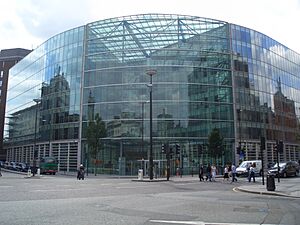
In 2004, Justin King became the new CEO. He launched a three-year plan called 'Making Sainsbury's Great Again'. He wanted to fix problems like shelves not being fully stocked. He decided to hire more staff for the shops and cut costs at the headquarters.
One of the big problems was with the automated warehouses that had been built. They often broke down, making it hard to get products to the shops. Sainsbury's later removed these failed automated systems.
Sainsbury's also sold its American subsidiary, Shaw's, in 2004. After Justin King's plan started, Sainsbury's saw sales grow for many quarters in a row. This was due to better distribution and a focus on fresh and healthy food.
Takeover Attempts (2007)
In 2007, several investment companies tried to buy Sainsbury's. The Sainsbury family, who still owned a significant part of the company, rejected these offers. They believed the offers were too low and that taking on too much debt would hurt the company in the long run.
Later, a Qatari investment company called Delta Two also tried to buy Sainsbury's. They were interested in Sainsbury's properties. However, this bid also failed due to problems in the financial markets and concerns about the company's pension scheme.
Developing Business (2009–2016)
In 2009, Sainsbury's bought 24 shops from The Co-operative Group, mostly in areas where Sainsbury's didn't have many shops.
In 2010, Sainsbury's became a main sponsor of the 2012 Paralympic Games in London. They sold Paralympic merchandise and were involved in events like the torch relay. After the games, they continued to support the British Paralympic Association.
In 2011, Sainsbury's opened its 1,000th self-service shop in Irvine, Scotland. In 2014, Sainsbury's took full ownership of Sainsbury's Bank, buying the remaining 50% from Lloyds Banking Group.
In 2014, Sainsbury's started powering one of its shops by turning food waste into gas to make electricity. This made them the first retailer to power a shop completely off the national electricity grid using its own methods.
Multi-Channel Retailer and Changes (2016–Present)
In 2016, Sainsbury's bought Home Retail Group for £1.4 billion. This deal included the popular catalogue chain Argos and the furniture retailer Habitat. This meant Sainsbury's became a "multi-channel" retailer, selling food, general goods, and financial services.
Sainsbury's continued to expand its online delivery and "Click and Collect" services. They also started putting Argos and Habitat sections inside their supermarkets.
To save money, Sainsbury's announced plans to cut costs and reorganize jobs in 2016 and 2017. This led to some job losses and changes in how shops were managed.
In 2018, Sainsbury's bought back the Nectar loyalty programme, giving them full control over it.
Also in 2018, Sainsbury's discussed merging with Asda, another large supermarket chain. If it had happened, it would have created the biggest supermarket company in the UK. However, the Competition and Markets Authority (the UK's competition watchdog) blocked the merger in 2019 because they were worried it would lead to higher prices for shoppers.
In 2020 and 2021, Sainsbury's announced more job changes and shop closures, especially for supermarket counters and some Argos standalone stores. They also closed their online fulfilment centre in Bromley-by-Bow, with online orders now handled by nearby shops.
In April 2021, the company reported a loss, partly due to investments in safety measures during the Coronavirus pandemic. The new CEO, Simon Roberts, started focusing on a "food first strategy" and promoting healthier eating.
In October 2024, Sainsbury's announced it was selling its Argos Financial Services credit card business to focus more on its main retail operations. In July 2024, the company's Travel Money business was sold.
Leaders of Sainsbury's
Here are the people who have led Sainsbury's over the years:
|
|
Sainsbury's Shops
Sainsbury's has two main types of shops: large supermarkets and smaller convenience shops.
| Type of Shop | Number | Total Area | Average Area | Percentage of Space |
||
|---|---|---|---|---|---|---|
| (m2) | (sq ft) | (m2) | (sq ft) | |||
| Supermarkets | 608 | 1,971,000 | 21,210,000 | 3,240 | 34,885 | 92% |
| Convenience shops | 820 | 179,675 | 1,934,000 | 219 | 2,360 | 8% |
| Total | 1,428 | 2,150,000 | 23,144,000 | - | - | 100% |
Sainsbury's is especially strong in London and the South-East of England.
Sainsbury's Supermarkets
Sainsbury's supermarkets are large shops that offer a wide range of products. They usually have fresh produce, meat, fish, groceries, and frozen food. Most also have self-service checkouts.
Depending on their size, these supermarkets might also have an in-shop bakery, a pizza counter, a cafe, or a clothing section (Tu clothing). Some even have an Argos shop or a petrol station. You might also find other smaller businesses inside, like a beauty hall, travel agents, or a Starbucks cafe.
During the coronavirus pandemic in March 2020, Sainsbury's supermarkets limited how many of each food item shoppers could buy. This was to make sure everyone had access to the products they needed.
Sainsbury's Fuel Stations
Sainsbury's has petrol stations at some of its supermarkets. They sell diesel and petrol. Sainsbury's started operating its own fuel stations in 1980.
Sainsbury's Café
Many Sainsbury's supermarkets have self-service cafes. In 2022, 200 of these cafes were closed. Sainsbury's confirmed in January 2025 that the remaining 61 cafes would close by April 11, 2025.
Sainsbury's Local Stores
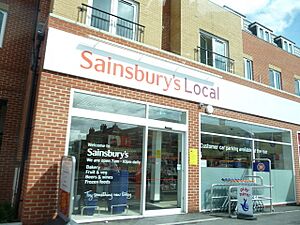
Sainsbury's Local shops are smaller convenience stores. They are designed for quick shopping trips. Sainsbury's has grown its number of Local shops by buying smaller chains like Bell's Stores and Jackson's Stores. All these acquired shops were eventually changed to the Sainsbury's Local brand.
In July 2013, the CEO Justin King said the company would focus on opening more convenience shops.
Sainsbury's Online Shopping
Sainsbury's offers an internet shopping service called "Sainsbury's Online." Customers can order groceries online and have them delivered to their homes. Sainsbury's first started offering online wine sales in 1995. By 1999, they had a full online grocery service.
Distribution Centres
Sainsbury's uses a network of distribution centres to get products to its shops. These centres are like big warehouses where products are stored and then sent out. There are regional distribution centres (RDCs) for everyday goods, and other centres for slower-moving items, frozen foods, and clothing.
Sainsbury's Other Businesses
Sainsbury's Bank
Sainsbury's Bank was created in 1997. It offers various financial services like car insurance, home insurance, loans, and credit cards. In October 2024, Sainsbury's announced it was selling its personal loans, credit cards, and savings business to NatWest.
Argos
Argos is a popular catalogue and online retailer that Sainsbury's bought in 2016. It sells a wide range of products, from electronics to toys and home goods.
Habitat
Habitat is a furniture store. Sainsbury's acquired it in 2019. Now, Habitat products are mainly sold within Sainsbury's supermarkets and through Argos.
Past Ventures
Sainsbury's has tried different types of shops and services over the years:
- Sainsbury's Freezer Centres: These shops, open from 1974 to 1986, sold only frozen food. They were later sold to another company.
- Sainsbury's SavaCentre: These were very large hypermarkets that sold both food and non-food items. They operated from 1977 to 2005 and were later converted into regular Sainsbury's superstores.
- Sainsbury's Calais Wine Shop: This shop in France sold alcohol to UK customers. It closed in 2010.
- Sainsbury's Market: An experimental shop in London that focused on fresh food counters. It closed in 2004.
- Mobile by Sainsbury's: A mobile phone network that Sainsbury's operated twice, from 2001-2003 and again from 2013-2016. Both times, it closed due to business reasons.
- Sainsbury's Pharmacy: Sainsbury's had pharmacies inside its supermarkets. In 2015, they sold these pharmacies to Lloydspharmacy. In June 2023, it was announced that all Lloydspharmacy locations within Sainsbury's stores would close.
Sainsbury's Products
Sainsbury's has its own brands for many products:
| Current Ranges | Description |
|---|---|
| by Sainsbury's | This is the main range of Sainsbury's own-brand food products. It includes over 6,500 different items. |
| Be Good To Yourself | Products in this range have less calories or fat, helping people eat healthier. |
| My Goodness! | Similar to "Be Good To Yourself," this range offers healthy food options. |
| Free From | Launched in 2002, these products are made for people with allergies to things like dairy, wheat, or gluten. |
| SO Organic | This range includes food and drinks made using organic farming methods. |
| Taste the Difference | This is Sainsbury's premium own-brand range, offering higher quality products. |
| Former Ranges | Description |
| Basics | This was a budget-friendly range with simple packaging. It was replaced by other sub-brands like "Stamford St." |
Marketing and Branding
Nectar Loyalty Card
Sainsbury's was one of the first companies to join the Nectar loyalty scheme in 2002. Customers earn points on almost everything they buy at Sainsbury's and other shops. These points can then be used for rewards. In 2018, Sainsbury's bought the Nectar loyalty programme, taking full control of it in the UK.
Sainsbury's Active Kids
Until 2017, Sainsbury's ran a yearly programme called "Active Kids." Customers collected vouchers when they shopped and could donate them to local schools or groups. These groups then used the vouchers to get sports equipment and other activity items from a special catalogue.
Slogans
Sainsbury's has used many different slogans over the years:
- "Quality perfect, Prices Lower" – Used in 1882.
- "Good Food Costs Less At Sainsbury's" – A very famous slogan used from the 1960s to the 1990s.
- "Making Life Taste Better" – Used from 1999 to 2005.
- "Try something new today" – Used from 2005 to 2011.
- "Live Well For Less" – Used from 2011 to 2021.
- "Helping Everyone Eat Better" – Introduced in February 2021.
- "Good food for all of us" – Launched in November 2023.
Sainsbury's was a major sponsor of the Paralympic Summer Games in London in 2012.
Staff and Community
Sainsbury's has opened food colleges to train its staff in skills like fishmongery and breadmaking. Many staff members have earned professional qualifications through this training.
'Our Sainsbury's' is a website for staff to find information, benefits, and connect with colleagues.
Employee Groups
Sainsbury's has groups like the 'Great Place to Work Group' where staff representatives meet to discuss working life and suggest improvements.
The 'Sainsbury's Staff Association' was started in 1947. Staff can join to get discounts and organise social events.
The 'Sainsbury's Veterans Association' also started in 1947. It helps former staff members who have worked for the company for 25 years or more stay in touch and receive benefits.
Sainsbury's Archive
Sainsbury's keeps an archive of over 16,000 items related to its business history at the Museum of London. This collection includes old documents, product packaging, and advertisements.
Ownership
As of February 2023, the main owners of Sainsbury's shares include:
- Qatar Investment Authority (QIA), which is a fund from Qatar.
- Vesa Equity Investment, owned by Czech billionaire Daniel Křetínský.
- Costcutter owner Bestway.
See also
 In Spanish: Sainsbury's para niños
In Spanish: Sainsbury's para niños


